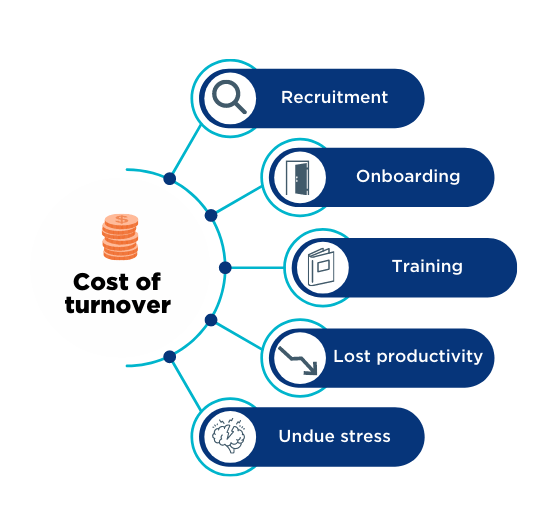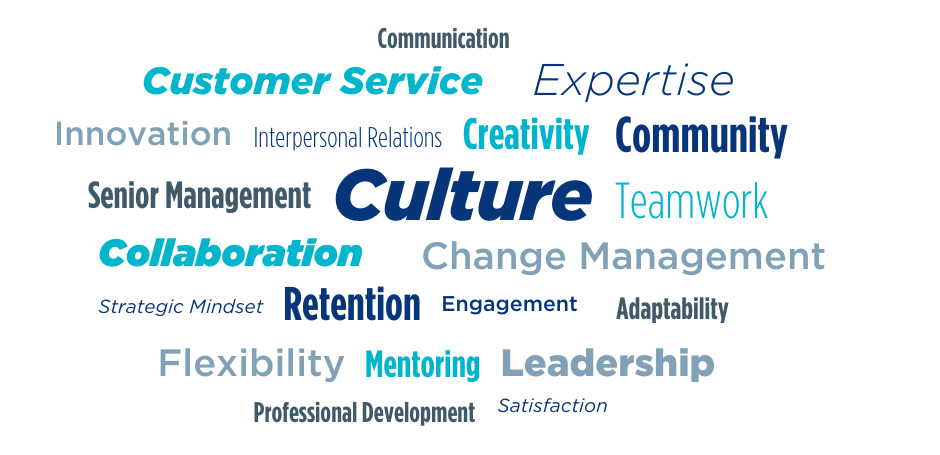Why leveraging climate assessments can help set your organization apart in today’s labour market
By Brookley Susser, HR Consultant – Strategic HR Consulting
You would be hard-pressed to find an employer today unaffected by the current labour market trends. In a 2021 report, the Business Development Bank of Canada indicated that more than half (55%) of small and medium-sized enterprises are struggling to hire workers, and more than a quarter (26%) of those employers are also having difficulties retaining employees. Skilled workers are in short supply compared to the growing labour demand in many sectors, leading to a candidate-driven market. In this environment, employers must take steps to set their organization apart from the countless other companies in the market to meet the high expectations of candidates. Conducting a workplace climate assessment can provide the knowledge leaders need to do just that.
Understanding employee expectations in today’s market
Finding the right organizational ‘fit’, feeling satisfied, meeting intrinsic needs, and receiving fair financial rewards are all expectations in today’s market – particularly within the millennial generation (Workstars). As the workforce continues to trend towards younger workers, these ideals continue to be embraced and taken a step or two further with the rise of online business practices. This has changed the way we fundamentally define professions, work-life balance, and the employee-employer relationship.
Employees, regardless of generation or profession, were struck by the realities brought on by the COVID-19 pandemic, prompting many to re-evaluate their priorities; both personal and professional. The bar on flexible work arrangements has been raised for employers, and a rising number of employees now expect this within their role. This has caused organizational loyalty to decrease, with many workers looking for greener pastures that represent professional opportunity, flexibility, and additional compensation. In other words, people are looking for the right ‘fit’ and value alignment between themselves (and their families) with prospective employers. In 2021, 60% of Canadians said they would leave their current job for the same position at another organization for a 10% raise (Angus Reid Institute, 2021).

Each organization’s status quo must be challenged to meet the expectations of what it means to be a top employer in this market. More than ever, employers must take a creative and intentional approach to how they choose to do business, to not only attract top talent but to keep it. In the article “17 Surprising Statistics about Employee Retention” TinyPulse reported that the average cost of replacing an employee who has exited the organization is equal to 33% of their annual salary. (This figure varies based on the skill level or specialization related to the position, as well as the existing succession strategies in place within the organization.) When we think of the cost of recruitment, onboarding, training, and the learning curve, not to mention the lost productivity and undue stress on remaining employees during vacancies, the total cost of turnover is staggering for most employers.
With all this in mind, retention strategy has never been a more relevant topic. Retention relies in large part on building and maintaining a healthy workplace culture to ensure employee satisfaction and engagement. Top leaders are championing a phase of corporate self-reflection, wherein they take the time to look inward, assess areas of opportunity, and formulate strategies to increase organizational health overall.
“Organizational health is the single greatest competitive advantage in any business.”
– Patrick Lencioni
When we talk about organizational health, the common phrases or buzzwords tend to be centred on obscure concepts. How does one practically and systematically assess an organization’s current state, while also taking steps to positively influence corporate culture, or organizational performance, behaviour, and resilience? HR professionals will tell you that the key to achieving true organizational health is to take a holistic approach, embedding best practice approaches within all organizational strategies, operations, and functions. A logical place to start is to first understand the current state of your organization’s work environment, which can be achieved by engaging in an organizational climate assessment.
What is a Climate Assessment?
Unlike the weather-related definition of climate, organizational climate assessments (sometimes referred to as workplace assessments) are a strategic tool used to better understand workplace dynamics. Climate assessments lean into employee perspectives in a way other measures simply cannot. Ideally, the findings will highlight what employees feel the organization is doing well, but often the findings focus on the root causes of any perceived challenges within the workplace and recommend strategies to overcome these challenges; in turn, contributing positively to organizational health.
Objectivity within assessments of a sensitive nature is essential for success, which is why many employers opt to engage a third-party partner to lead the process. Employees are more likely to provide honest and transparent feedback about their workplace to someone who doesn’t work within the same walls. Best practice in climate assessment methodology includes a variety of tools to gather data. Some of the most commonly used tools include targeted surveys, focus groups, formal interviews and informal conversations with employees about the work environment. Approaches should be customized to best serve the assessment group and ideal project outcomes, and are influenced by group size and demographic, industry, and operational factors.
Facing the Realities
As climate assessments are a strategic tool, they can be leveraged for many different purposes. The reality is that most leaders don’t explore this option until there are identifiable concerns in the workplace that must be addressed. Key indicators that a climate assessment may be needed to address organizational challenges can include shifting trends in employee engagement scores, an increase in absenteeism, complaints, conflict, or employee turnover.
Key indicators that a climate assessment may be needed include shifting trends in employee engagement scores, an increase in absenteeism, complaints, conflict, or employee turnover.
In May 2021, upwards of 1000 employed (full-time) Canadians were surveyed by the Angus Reid Institute to better understand the current benchmarks in Canadian workplace culture. Results indicated that more than 36% of Canadians agree that senior managers don’t make an effort to listen to and connect with employees. Of significant concern, over 30% of Canadians believe that people get away with bullying at their organizations. Perceptions of this nature have a direct impact on employee engagement, and therefore organizational loyalty and retention.
These staggering statistics indicate that there may be perceptions amongst employees that leaders do not fully understand. It is important to understand that perception doesn’t always reflect reality within the workplace. Regardless of reality, perceptions of the work environment must be seriously considered, as that is what can make or break an organization’s image in the marketplace and impact future opportunities. Often, negative perceptions about a workplace are centred on interactions and experiences with particular individuals within that workplace.
Rob Sutton’s impactful book, “The No Asshole Rule: Building a Civilized Workplace and Surviving One That Isn’t” introduced the idea that there is a total cost associated with keeping employees within your organization that negatively impacts the engagement of others. There is a growing trend in companies to consider the Total Cost of Jerks (TCJ) impact on the workforce and workplace culture; what is interesting to note is that there is also a cost of not knowing or being aware of the ‘jerks’ within your workplace. Proactive approaches to understanding your organization’s workplace culture may be needed to assess and consider the TCJ within your organization.
Fostering a Strategic Mindset
More and more leaders are taking an intentional approach to creating a corporate culture and identity. Generating strong connections between an organization’s values, vision, and strategic plan, and how a business operates on the ground, are key to this process. Climate assessments are a robust tool for leadership to understand how employees feel about current operations and generate ideas for alignment at that functional day-to-day level of the business.
All climate assessments must be customized to the needs of the organization; each one should have unique objectives focused on the organization’s guiding principles, and main drivers of engagement.

As we all know, the best-laid plans for implementing change of any kind—culture related or otherwise—within the workplace aren’t always embraced unless there is buy-in from the outset. Organizations preparing for change may also proactively seek a climate assessment or a similar approach as part of the change management strategy. The ability to get a pulse on the current environment, employee perspectives and how they may feel about change before it happens is akin to the saying ‘always be prepared’ — it just makes good sense.
The Good (and the Challenging)
The people-side of business continues to challenge the most successful organizations. What we know is that when responding to the continuing demands of the market, a focus on organizational health can leave organizations better prepared to respond to these challenges. Remaining informed about the realities within your organization is an important part of responsible and strategic leadership.
Although climate assessments can be considered a significant investment for organizations that may not be actively experiencing challenges within the work environment, knowledge is powerful, especially when it comes to understanding how to reduce the high cost of turnover. Climate assessments can contribute to impactful corporate self-reflection, the ability to build intentional corporate culture, and emerging as an employer who promotes both organizational and individual health and well-being.

About Brookley Susser
Brookley is an HR Consultant with the Strategic HR Consulting team. Working primarily within the realm of organizational health, she partners with clients on projects that focus on engagement, culture, organizational design, and performance.
Brookley is passionate about empowering leaders to develop and lead strong teams. Her HR practice is rooted in a solution-focused approach, utilizing effective communication, creative problem solving and high attention to detail to achieve results.
